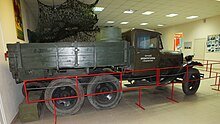GAZ-AAA
| GAZ | |
|---|---|
|
GAZ-AAA in a museum in Vladivostok
|
|
| GAZ-AAA | |
| Manufacturer: | Gorkovsky Avtomobilny Zavod |
| Sales designation: | ГАЗ-ААА |
| Production period: | 1934-1943 |
| Previous model: | none |
| Successor: | none |
| Technical specifications | |
| Engines: |
Gasoline engine : 3.3 liters |
| Power: | 37 kW |
| Payload: | 2 t |
| Perm. Total weight: | 4.5 t |
The GAZ-AAA ( Russian ГАЗ-ААА ) is a light truck that was produced by GAZ in the years 1934-1943 and was located below the ZIS-6 . The model is the three-axle version of the GAZ-AA . A few vehicles with a bus body were manufactured under the designation GAZ-05-193 .
History of the vehicle
In the 1930s, the Red Army had a significant need for all-terrain trucks. Both GAZ and the Sawod imeni Stalina designed half-track vehicles , but they did not go into series production. Then NATI , an institute for vehicle construction, developed the GAZ-AAA from the light truck GAZ-AA . The most important change was the addition of the second rear axle, which enabled a higher total weight of the vehicle and better propulsion in the field.
Over the years the vehicles have been simplified, particularly due to the shortage of materials in the 1940s. The roof was made of canvas and the doors were made of wood, the fenders were simplified and the right headlight was saved. There was a similar procedure with the GAZ-AA and the ZIS-5 .
As the main buyer of the vehicles, the Red Army mainly used them to transport weapons, which meant that the vehicles were quickly lost in the war. Only the vehicles that were used as workshop vehicles achieved longer periods of use.
Production was stopped in 1943 due to the war. On the basis of the GAZ-AAA, there was also an attempt to produce a three-axle truck with all-wheel drive. Due to the war, this project also ended after the production of a prototype, which was designated as the GAZ-33. The BA-10 armored reconnaissance vehicle was based on the chassis of the GAZ-AAA.
Technical specifications
- Engine: four-cylinder petrol engine
- Displacement: 3285 cm³
- Power: 50 hp (37 kW) at 2800 revolutions per minute, 42 hp (31 kW) at 2600 revolutions per minute
- Maximum speed loaded: 65 km / h
- Fuel consumption: 25 to 27 l / 100 km
- Tank capacity: 60 + 40 l
- Transmission: mechanical, 4 gears forwards + 1 backwards as well as reduction for all gears
- Brakes: mechanical
- Drive formula : 6 × 4
- Number of units produced: 37,373
mass and weight
- Length: 5335 mm
- Width: 2040 mm
- Height: 1970 mm
- Wheelbase: 3200 mm + 940 mm
- Front track: 1405 mm
- Rear track: 1600 mm
- Payload: 2000 kg (1500 kg on unpaved road)
- Empty weight: 2475 kg
- Permissible total weight: 4475 kg
Whereabouts
Despite the number of almost 40,000 vehicles produced, very few trucks of this type have survived today. One of them is the vehicle shown on this page (color photographs). Since 1992 it has been owned by an automobile museum in Vladivostok. In 1946 it was brought by sea to the village of Amgu , which is on the Russian coast of the Sea of Japan , 750 kilometers north of Vladivostok. There the truck was used to supply a lighthouse until 1956, when it was parked as defective. In exchange for a GAZ-52 , the vehicle was brought to the museum, was restored and has been on display ever since.
GAZ-05-193
A closed bus body was built on the chassis of the GAZ-AAA under the designation GAZ-05-193. It was not a bus in the strict sense of the word, as only nine seats were built. Rather, the vehicle was used for special purposes. 237 vehicles of this type were produced from 1936 to 1945. Here, too, the simplifications described above came into force from 1942. The technical data largely corresponded to those of the GAZ-AAA. However, the external dimensions (length 5300 mm, width 2100 mm) have been changed due to the changed body shape. The curb weight increased to 3140 kilograms.
A visually and technically very similar vehicle was the GAZ-03-30 , a civilian bus based on the two-axle GAZ-AA.
Remarks
- ↑ These changes took effect mainly after 1940. Compare drawings from 1937, 1940 and 1943 .
- ↑ In the literature there is occasionally the indication of 1750 kilograms. This is the curb weight of the significantly lighter GAZ-AA.
Web links
- Website oldrussiancars.com Accessed on July 18, 2011 (English)
- Website of the Vehicle Museum in Vladivostok on GAZ-AAA (Russian)
- Website with historical photographs and drawings of the model (English)
- Technical Data (English)
- Website for GAZ-05-193 with pictures of the vehicle (English)



